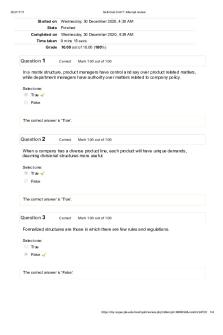Quiz 7 Review sheet - 1112 PDF

| Title | Quiz 7 Review sheet - 1112 |
|---|---|
| Author | Navneet Kaur |
| Course | Oral Anatomy |
| Institution | New York City College of Technology |
| Pages | 2 |
| File Size | 45.2 KB |
| File Type | |
| Total Downloads | 63 |
| Total Views | 150 |
Summary
1112...
Description
Quiz 7 Review sheet – Waheguru Cranial Nerve I – OLFACTORY Afferent Smell Cribriform plate of ethmoid bone Cranial Nerve II – OPTIC Afferent Vision (retina primary visual cortex in occipital lobes) Optic canal (apex of orbit) Cranial Nerve III – OCCULOMOTOR Efferent Muscles of moving eye (somatic efferent innervation) Constriction of pupil of eye (circular muscle of iris) Accommodations of lens (ciliary muscle) Parasympathetic efferent innervation Superior Orbital Fissure (Sphenoid Bone) Cranial Nerve IV – TROCHLEAR NERVE Efferent Eyes muscles Superior Orbital Fissure (Sphenoid Bone) Cranial Nerve V – TRIGEMINAL NERVE Efferent and Sensory 3 divisions: Ophthalmic (S) , Maxillary (S), Mandibular (S&E) SOF(V1) -- Foramen Rotundum(V2) -- Foramen Ovale(V3) all in Sphenoid Cranial Nerve VI – ABDUCENS NERVE Efferent Eye muscles SOF Cranial Nerve VII – FACIAL NERVE Mixed – Efferent Somatic, Efferent Parasympathetic, Afferent Sensory Efferent somatic : 1) Muscles of facial Expression 2) Stapedius Muscle in middle ear Efferent parasympathetic: 1) lacrimal gland 2) Submandibular, sublingual Salivary glands Afferent sensory – taste sensation to anterior 2/3 of tongue via Chorda Tympani nerve Major motor branches exits: Stylomastoid foramen; Chorda tympani exits from Petrotypmanic fissure (next to TMJ) – both in temporal bone. Cranial Nerve VIII – VESTIBULOCOCHLEAR NERVE Afferent 2 major branches: 1) Vestibular: Sensory innervation of vestibule apparatus semicircular canals (sense of balance) 2) Cochlear - cochlea of inner ear – hearing Nerves travel from cochlea temporal lobes of cortex Travels through internal acoustic meatus.
Cranial Nerve IX – GLOSSOPHARYNGEAL NERVE Mixed – efferent somatic, efferent autonomic/parasympathetic, afferent innervation Efferent somatic (motor) – controls Stylopharyngeous muscle Efferent autonomic (parasympathetic) – Parotid Salivary Gland Afferent: general sensation and taste sensation to Posterior 1/3 of tongue, sensory innervation to pharynx. Cranial Nerve X – VAGUS NERVE “wandering” Mixed – efferent somatic, afferent, and efferent parasympathetic. 80-90% of nerves fibers are sensory, carrying sensory information to brain from viscera and body organs Efferent Somatic (motor) – muscles of soft palate, pharynx and larynx. Efferent/parasympathetic innervation of heart: slows heart rate. Cranial Nerve XI – ACCESSORY NERVE Efferent Muscles of neck, soft palate and pharynx Vagus and Glossopharyngeal nerves through Jugular Foramen (located in base of skull, formed by temporal bone and occipital bone) Cranial Nerve XII – HYPOGLOSSAL NERVE Efferent somatic Muscles of tongue Hypoglossal canal (occipital bone)...
Similar Free PDFs

Quiz 7 Review sheet - 1112
- 2 Pages

Review Sheet Topic {7}
- 3 Pages

PSY365 Quiz 3 Review Sheet
- 10 Pages

HITT 1305 Chapter 7 Review Sheet
- 2 Pages

CC3-1112 mécanisme réactionnel
- 4 Pages

Review sheet
- 42 Pages

Self-Quiz Unit 7 Attempt review
- 4 Pages

Self-Quiz Unit 7 Attempt review
- 3 Pages

Review Quiz Attempt review
- 20 Pages

Review Quiz
- 6 Pages

Quiz Chapter 7 - Quiz
- 4 Pages

Chapter 7 quiz#7
- 3 Pages
Popular Institutions
- Tinajero National High School - Annex
- Politeknik Caltex Riau
- Yokohama City University
- SGT University
- University of Al-Qadisiyah
- Divine Word College of Vigan
- Techniek College Rotterdam
- Universidade de Santiago
- Universiti Teknologi MARA Cawangan Johor Kampus Pasir Gudang
- Poltekkes Kemenkes Yogyakarta
- Baguio City National High School
- Colegio san marcos
- preparatoria uno
- Centro de Bachillerato Tecnológico Industrial y de Servicios No. 107
- Dalian Maritime University
- Quang Trung Secondary School
- Colegio Tecnológico en Informática
- Corporación Regional de Educación Superior
- Grupo CEDVA
- Dar Al Uloom University
- Centro de Estudios Preuniversitarios de la Universidad Nacional de Ingeniería
- 上智大学
- Aakash International School, Nuna Majara
- San Felipe Neri Catholic School
- Kang Chiao International School - New Taipei City
- Misamis Occidental National High School
- Institución Educativa Escuela Normal Juan Ladrilleros
- Kolehiyo ng Pantukan
- Batanes State College
- Instituto Continental
- Sekolah Menengah Kejuruan Kesehatan Kaltara (Tarakan)
- Colegio de La Inmaculada Concepcion - Cebu



